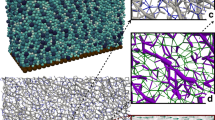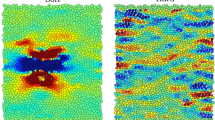Abstract.
The paper reviews some peculiar properties exhibited by granular flows. We emphasize the inability of kinetic theory and of Bagnold’s heuristic approach to describe the rapid regime of densely packed flows, characterized by the breakdown of the binary collision picture and by multibody long-lasting contacts. We suggest that deformation waves through the continuous paths of contacts can be effective to transport momentum and energy through the bulk, in a time very short compared to the inverse of the shear rate. This mechanism could explain some key rheological features encountered in dense granular materials.
Similar content being viewed by others
References
GDR MiDi, this issue, p. \(\bullet\).
For recent reviews, see J.T. Jenkins in Physics of Dry Granular Media, edited by H.H. Herrmann, J.P. Hovi, S. Luding (Kluwer, Dordrecht, 1998) p. 353; I. Goldhirsch, ibid. p. 371; J. Rajchenbach, Adv. Phys. 49, 229 (2000).
H.H. Shen, M. Babic, Mechanics of Granular Materials, edited by M. Oda, K. Iwashita (Balkema, Rotterdam, 1999) Chapt. 5.
C. Coste, B. Gilles, Eur. Phys. J. B 7, 155 (1999).
J. Rajchenbach, E. Clément, J. Duran, Experiments in model granular media: a study of gravity flows, in Fractal Aspects of Materials, edited by F. Family, P. Meakin, B. Sapoval, R. Wool, Vol. 367 (M.R.S. Symposium, Pittsburgh, 1995) p. 528.
S. Dippel, Microscopic dynamics of granular materials, PhD Thesis, Höchstleistungsrechenzentrum, Forschungszentrum Jülich (1998).
A.J.C. de Barré de Saint-Venant, C. R. Acad. Sci. Paris 31, 283 (1850).
Nevertheless, this approximation becomes correct for slope angles close to the angle of repose, for which the part of the losses related to inelasticity and wave damping are negligible compared to that originating in frictional sliding.
W. Goldsmith, Impact (Edward Arnold, London, 1960).
L. Labous, A.D. Rosato, R. Dave, Phys. Rev. E 56, 5717 (1997).
A.P. Ivanov, J. Appl. Math. Mech. 61, 342 (1997).
E. Falcon, C. Laroche, S. Fauve, C. Coste, Eur. Phys. J. B 5, 111 (1998).
R.A. Bagnold, Proc. R. Soc. London, Ser. A 255, 49 (1954).
O. Pouliquen, Phys. Fluids 11, 542 (1999).
J. Rajchenbach, Phys. Rev. Lett. 90, 144302 (2003).
M. Nagakawa, S.A. Altobelli, A. Caprihan, E. Fukushima, E.K. Jeong, Exp. Fluids 16, 54 (1993).
I. Vardoulakis, J. Sulem, Bifurcation Analysis in Geomechanics (Chapman and Hall, London, 1995).
J.J. Moreau, Numerical investigation of shear zones in granular materials, in Proceedings of the HLRZ-Workshop on friction, Arching, Contact Dynamics, edited by P. Grassberger, D.E. Wolf (World Scientific, Singapore, 1997) p. 233.
J.P. Bardet, J. Proubet, Géotechnique 41, 599 (1991).
J.K. Morgan, M.S. Boettcher, J. Geophys. Res. B 104, 2703 (1999).
C. Thornton, L. Zhang, in Powders and Grains 2000, edited by Y. Kishino (Swets and Zeitliger, Lisse, The Netherlands, 2001) p. 183.
M. Lätzel, S. Luding, H.J. Herrmann, D.W. Howell, R.P. Behringer, Eur. Phys. J. E 11, 325 (2003).
O.R. Walton, R.L. Braun, Acta Mech. 63, 73 (1986).
J.T. Jenkins, M.W. Richman, J. Fluid. Mech. 192, 313 (1988).
J. Christoffersen, M. Mehrabadi, C. Nemat-Nasser, J. Appl. Mech. 48, 339 (1981).
J.D. Goddard, Continuum modeling of granular assemblies, in Physics of Dry Granular Media, edited by H. Herrmann, J.P. Hovi, S. Luding (Kluwer Academic Publishers, Dordrecht, 1998) p. 1.
Note that the forces involved during the impact phenomenon do not obey the scaling \({\bf f}_{ij}\rightarrow \alpha {\bf f}_{ij},\; t \rightarrow t/\sqrt{\alpha}\), owing to the nonlinear nature of the Hertzian contact. The homothetic transformation of the shear rate as \(\dot{\gamma} \rightarrow \sqrt{\alpha} \dot{\gamma}\) leads to a transformation of the impact duration as \(\tau \rightarrow \alpha^{-1/10} \tau\); see L.D. Landau, E.M. Lifschitz, Theory of Elasticity (Pergamon, New York, 1986).
D.V. Orpe, A.V. Khakhar, Phys. Rev. E 64, 031202 (2001).
E. Azanza, Ecoulements granulaires bidimensionnels sur un plan incliné, Thesis Dissertation, Ecole Nationale des Ponts et Chaussée (Noisy le Grand, France, 1998).
S.B. Savage, C.K.K. Lun, J. Fluid. Mech. 189, 311 (1988)
E. Azanza, F. Chevoir, P. Moucheront, J. Fluid Mech. 400, 199 (1999).
Author information
Authors and Affiliations
Additional information
Received: 25 June 2004, Published online: 31 August 2004
PACS:
45.70.-n Granular systems
J. Rajchenbach: On leave from LMDH (CNRS-UMR 7603), Université P. et M. Curie, 75005 Paris, France.
Rights and permissions
About this article
Cite this article
Rajchenbach, J. Some remarks on the rheology of dense granular flows. Eur. Phys. J. E 14, 367–371 (2004). https://doi.org/10.1140/epje/i2004-10025-1
Issue Date:
DOI: https://doi.org/10.1140/epje/i2004-10025-1




